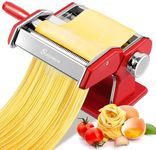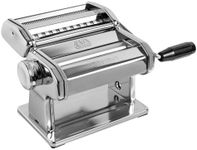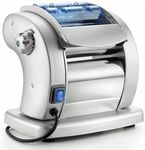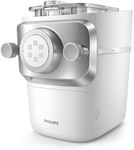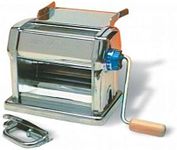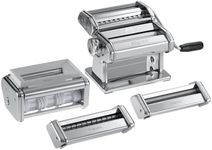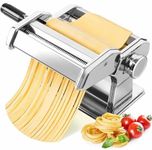Buying Guide for the Best Pasta Machines
Choosing the right pasta machine can greatly enhance your pasta-making experience, allowing you to create fresh, homemade pasta with ease. When selecting a pasta machine, it's important to consider several key specifications that will determine the machine's suitability for your needs. Understanding these specifications will help you make an informed decision and ensure that you pick the best fit for you.TypePasta machines come in two main types: manual and electric. Manual machines require you to turn a hand crank to roll and cut the dough, which can be more labor-intensive but offers greater control. Electric machines automate the process, making it quicker and easier, but they can be more expensive and less hands-on. Choose a manual machine if you enjoy the traditional pasta-making process and don't mind the extra effort. Opt for an electric machine if you prefer convenience and speed.
MaterialPasta machines are typically made from stainless steel, chrome-plated steel, or aluminum. Stainless steel is durable, resistant to rust, and easy to clean, making it a popular choice. Chrome-plated steel offers similar benefits but may require more maintenance to prevent rust. Aluminum machines are lightweight and often more affordable, but they may not be as durable. Consider stainless steel for longevity and ease of maintenance, especially if you plan to use the machine frequently.
Adjustable Thickness SettingsThis feature allows you to control the thickness of your pasta sheets. Most machines offer multiple settings, ranging from very thin to thick. This is important because different pasta types require different thicknesses. For example, lasagna sheets are thicker than fettuccine. Look for a machine with a wide range of thickness settings to give you versatility in the types of pasta you can make. If you enjoy experimenting with various pasta recipes, this feature is essential.
Cutting AttachmentsMany pasta machines come with interchangeable cutting attachments that allow you to make different types of pasta, such as spaghetti, fettuccine, and tagliatelle. The more attachments a machine has, the more versatile it will be. If you like to make a variety of pasta shapes, choose a machine with multiple cutting attachments. If you prefer to stick to one or two types, a machine with fewer attachments may suffice.
Ease of CleaningPasta machines can be tricky to clean, especially if dough gets stuck in the rollers or cutters. Some machines have removable parts that make cleaning easier. Look for machines that are easy to disassemble and clean, as this will save you time and effort. If you plan to use the machine frequently, ease of cleaning is an important consideration to ensure that the machine remains in good working condition.
Size and StoragePasta machines can vary in size, and it's important to consider how much counter space you have available. Larger machines may offer more features but can take up more space. Smaller machines are more compact and easier to store but may have fewer features. Consider the size of your kitchen and where you will store the machine when not in use. Choose a size that fits your space and storage needs.
